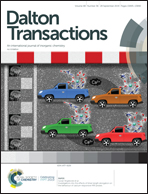Syntheses of three new isostructural lanthanide coordination polymers with tunable emission colours through bimetallic doping, and their luminescence sensing properties†
Abstract
Tuning the emissive color changes of lanthanide (Ln) complexes is an important and appealing project for promoting the applications of Ln-complexes. A solvothermal reaction of 4-cyano-3-methylbenzoic acid (HL) and Ln(NO3)3·6H2O affords three isostructural Ln-complexes [Eu(L)3(H2O)2]n (1-Ln) (Ln = Eu, Gd and Tb) with one-dimensional chain structures. 1-Eu and 1-Tb show bright red and green emissions with absolute quantum yields of 3.06% and 11.96%, respectively, and the energy transfer was analyzed in detail through combined calculations. Interestingly, a series of heterometallic doped 1-TbxEu1−x coordination polymers were also obtained by mixing different ratios of Eu3+ and Tb3+ ions, which possess continuous luminescent color changes from green to yellow, orange and red. In addition, 1-Eu exhibits high quenching efficiency and low detection limit (∼10−4 M) for the simultaneous sensing of MnO4−, CrO42− and Cr2O72− ions in water.



 Please wait while we load your content...
Please wait while we load your content...